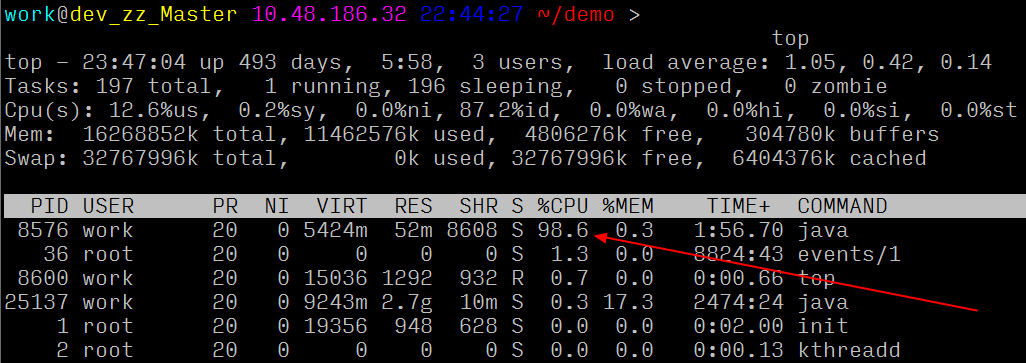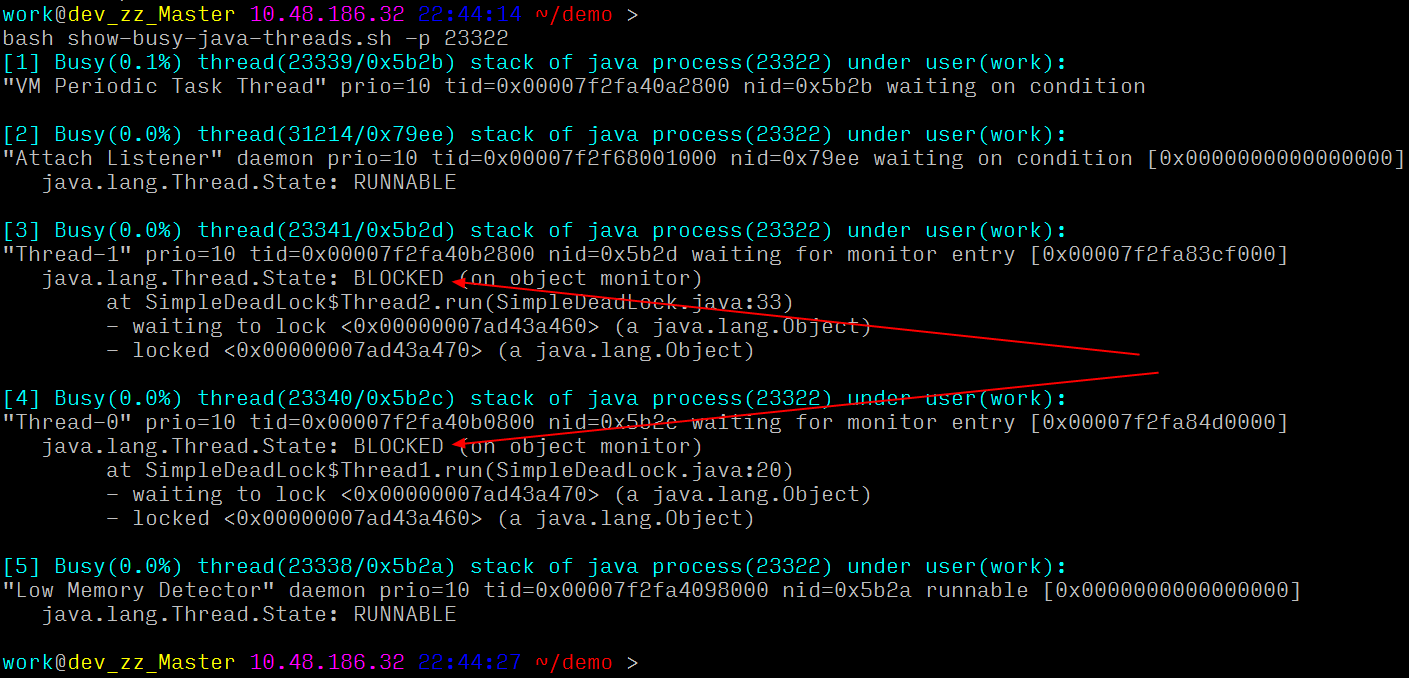标签:load windows 美剧 注意 oschina jdk png 机器 .sh
经常做后端服务开发的同学,或多或少都遇到过 CPU 负载特别高的问题。尤其是在周末或大半夜,突然群里有人反馈线上机器负载特别高,不熟悉定位流程和思路的同学可能登上服务器一通手忙脚乱,定位过程百转千回。

对此,也有不少同学曾经整理过相关流程或方法论,类似把大象放进冰箱要几步,传统的方案一般是4步:
但是对于线上问题定位来说,分秒必争,上面的 4 步还是太繁琐耗时了,有没有可能封装成为一个工具,在有问题的时候一键定位,秒级找到有问题的代码行呢?
当然可以!工具链的成熟与否不仅体现了一个开发者的运维能力,也体现了开发者的效率意识。淘宝的oldratlee 同学就将上面的流程封装为了一个工具:show-busy-java-threads.sh(点击可直接下载,或参考文末链接下载),可以很方便的定位线上的这类问题,下面我会举两个例子来看实际的效果。
快速安装使用:
source <(curl -fsSL https://raw.githubusercontent.com/oldratlee/useful-scripts/master/test-cases/self-installer.sh)
import java.util.ArrayList;
import java.util.List;
import java.util.regex.Matcher;
import java.util.regex.Pattern;
public class RegexLoad {
public static void main(String[] args) {
String[] patternMatch = {"([\\w\\s]+)+([+\\-/*])+([\\w\\s]+)",
"([\\w\\s]+)+([+\\-/*])+([\\w\\s]+)+([+\\-/*])+([\\w\\s]+)"};
List<String> patternList = new ArrayList<String>();
patternList.add("Avg Volume Units product A + Volume Units product A");
patternList.add("Avg Volume Units / Volume Units product A");
patternList.add("Avg retailer On Hand / Volume Units Plan / Store Count");
patternList.add("Avg Hand Volume Units Plan Store Count");
patternList.add("1 - Avg merchant Volume Units");
patternList.add("Total retailer shipment Count");
for (String s :patternList ){
for(int i=0;i<patternMatch.length;i++){
Pattern pattern = Pattern.compile(patternMatch[i]);
Matcher matcher = pattern.matcher(s);
System.out.println(s);
if (matcher.matches()) {
System.out.println("Passed");
}else
System.out.println("Failed;");
}
}
}
}
编译、运行上述代码之后,咱们就能观察到服务器多了一个 100% CPU 的 java 进程:

怎么使用呢?
show-busy-java-threads.sh
# 从 所有的 Java进程中找出最消耗CPU的线程(缺省5个),打印出其线程栈。show-busy-java-threads.sh -c <要显示的线程栈数>
show-busy-java-threads.sh -c <要显示的线程栈数> -p <指定的Java Process>
##############################
# 注意:
##############################
# 如果Java进程的用户 与 执行脚本的当前用户 不同,则jstack不了这个Java进程。
# 为了能切换到Java进程的用户,需要加sudo来执行,即可以解决:
sudo show-busy-java-threads.sh
示例:
work@dev_zz_Master 10.48.186.32 23:45:50 ~/demo >
bash show-busy-java-threads.sh
[1] Busy(96.2%) thread(8577/0x2181) stack of java process(8576) under user(work):
"main" prio=10 tid=0x00007f0c64006800 nid=0x2181 runnable [0x00007f0c6a64a000]
java.lang.Thread.State: RUNNABLE
at java.util.regex.Pattern$GroupHead.match(Pattern.java:4168)
at java.util.regex.Pattern$Loop.match(Pattern.java:4295)
...
at java.util.regex.Matcher.match(Matcher.java:1127)
at java.util.regex.Matcher.matches(Matcher.java:502)
at RegexLoad.main(RegexLoad.java:27)
[2] Busy(1.5%) thread(8591/0x218f) stack of java process(8576) under user(work):
"C2 CompilerThread1" daemon prio=10 tid=0x00007f0c64095800 nid=0x218f waiting on condition [0x0000000000000000]
java.lang.Thread.State: RUNNABLE
[3] Busy(0.8%) thread(8590/0x218e) stack of java process(8576) under user(work):
"C2 CompilerThread0" daemon prio=10 tid=0x00007f0c64093000 nid=0x218e waiting on condition [0x0000000000000000]
java.lang.Thread.State: RUNNABLE
[4] Busy(0.2%) thread(8593/0x2191) stack of java process(8576) under user(work):
"VM Periodic Task Thread" prio=10 tid=0x00007f0c640a2800 nid=0x2191 waiting on condition
[5] Busy(0.1%) thread(25159/0x6247) stack of java process(25137) under user(work):
"VM Periodic Task Thread" prio=10 tid=0x00007f13340b4000 nid=0x6247 waiting on condition
work@dev_zz_Master 10.48.186.32 23:46:04 ~/demo >可以看到,一键直接定位异常代码行,是不是很方便?
import java.util.*;
public class SimpleDeadLock extends Thread {
public static Object l1 = new Object();
public static Object l2 = new Object();
private int index;
public static void main(String[] a) {
Thread t1 = new Thread1();
Thread t2 = new Thread2();
t1.start();
t2.start();
}
private static class Thread1 extends Thread {
public void run() {
synchronized (l1) {
System.out.println("Thread 1: Holding lock 1...");
try { Thread.sleep(10); }
catch (InterruptedException e) {}
System.out.println("Thread 1: Waiting for lock 2...");
synchronized (l2) {
System.out.println("Thread 2: Holding lock 1 & 2...");
}
}
}
}
private static class Thread2 extends Thread {
public void run() {
synchronized (l2) {
System.out.println("Thread 2: Holding lock 2...");
try { Thread.sleep(10); }
catch (InterruptedException e) {}
System.out.println("Thread 2: Waiting for lock 1...");
synchronized (l1) {
System.out.println("Thread 2: Holding lock 2 & 1...");
}
}
}
}
}执行之后的效果:

如何用工具定位:

一键定位:可以清晰的看到线程互相锁住了对方等待的资源,导致死锁,直接定位到代码行和具体原因。
通过上面两个例子,我想各位同学应该对这个工具和工具能解决什么问题有了比较深刻的了解了,遇到 CPU 100% 问题可以从此不再慌乱。但是更多的还是依赖大家自己去实践,毕竟实践出真知嘛~
除了正文提到的 show-busy-java-threads.sh,oldratlee 同学还整合和不少常见的开发、运维过程中涉及到的脚本工具,觉得特别有用的我简单列下:
PS:目前Greys仅支持Linux/Unix/Mac上的Java6+,Windows暂时无法支持
Greys是一个JVM进程执行过程中的异常诊断工具,可以在不中断程序执行的情况下轻松完成问题排查工作。和HouseMD一样,Greys-Anatomy取名同名美剧“实习医生格蕾”,目的是向前辈致敬。代码编写的时候参考了BTrace和HouseMD两个前辈的思路。
使用greys对java程序进行运行时跟踪(不传参数,需要先greys -C pid,再greys)。支持的操作有:
使用sjk对Java诊断、性能排查、优化工具
[1] oldratlee/useful-scripts
https://github.com/oldratlee/useful-scripts
[2] awesome-scripts
https://github.com/superhj1987/awesome-scripts
[3] JDK自带工具之问题排查场景示例
标签:load windows 美剧 注意 oschina jdk png 机器 .sh
原文地址:http://www.cnblogs.com/zhaoxinshanwei/p/7456851.html